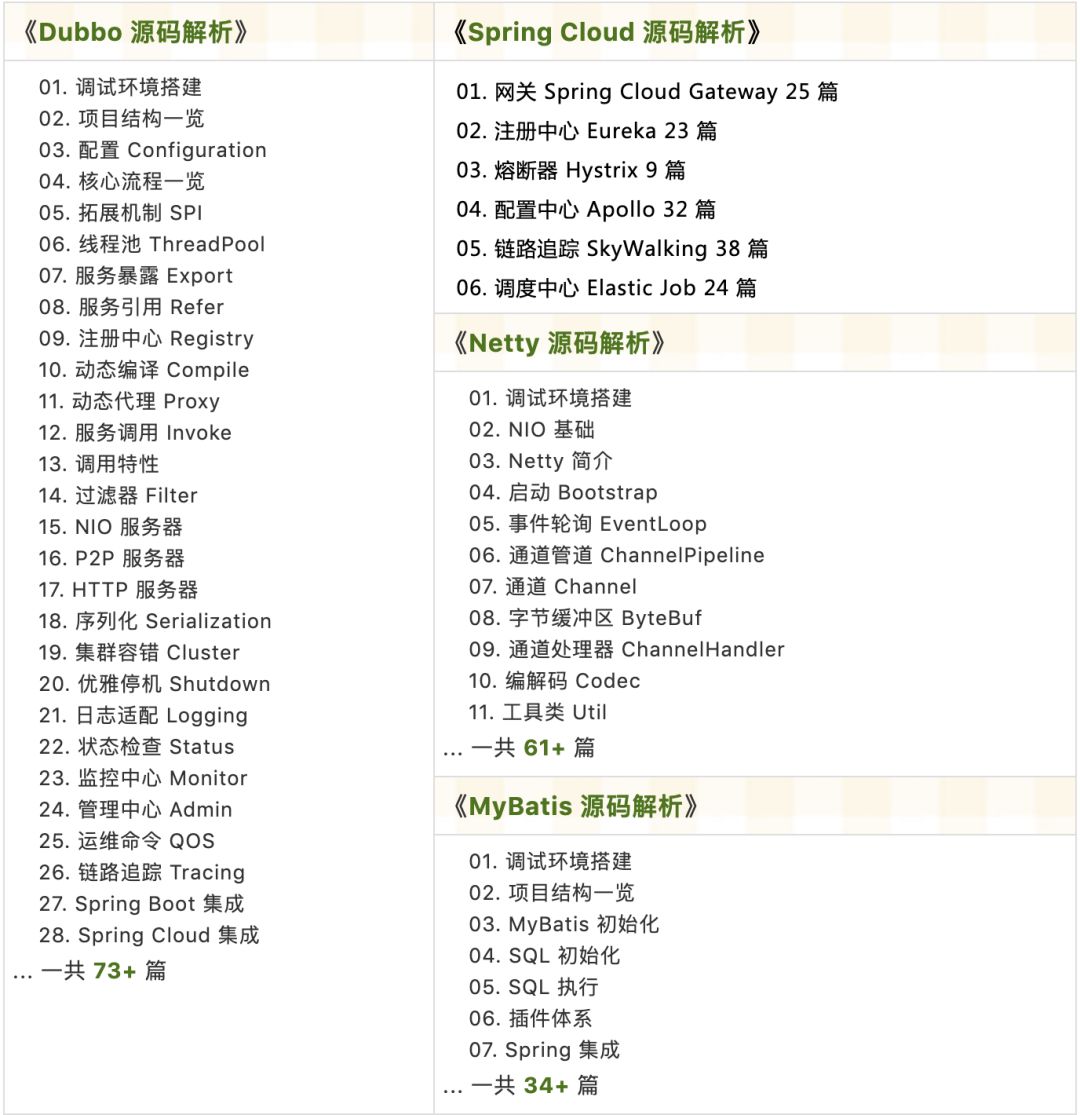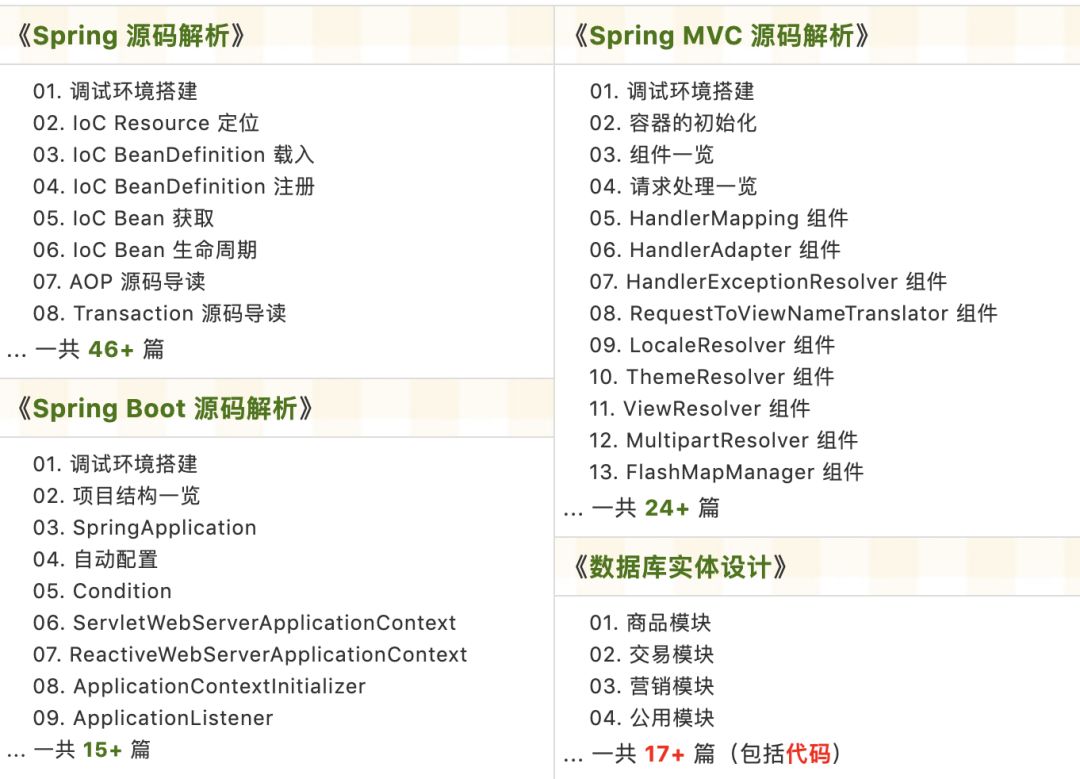点击上方“Java基基”,选择“设为星标”
做积极的人,而不是积极废人!
每天 14:00 更新文章,每天掉亿点点头发...
源码精品专栏

最近项目进入联调阶段,服务层的接口需要和协议层进行交互,协议层需要将入参[json字符串]组装成服务层所需的json字符串,组装的过程中很容易出错。入参出错导致接口调试失败问题在联调中出现很多次,因此就想写一个请求日志切面把入参信息打印一下,同时协议层调用服务层接口名称对不上也出现了几次,通过请求日志切面就可以知道上层是否有没有发起调用,方便前后端甩锅还能拿出证据
写在前面
本篇文章是实战性的,对于切面的原理不会讲解,只会简单介绍一下切面的知识点
基于 Spring Boot + MyBatis Plus + Vue & Element 实现的后台管理系统 + 用户小程序,支持 RBAC 动态权限、多租户、数据权限、工作流、三方登录、支付、短信、商城等功能。
项目地址:https://github.com/YunaiV/ruoyi-vue-pro
切面介绍
面向切面编程是一种编程范式,它作为OOP面向对象编程的一种补充,用于处理系统中分布于各个模块的横切关注点,比如事务管理 、权限控制 、缓存控制 、日志打印 等等。AOP把软件的功能模块分为两个部分:核心关注点和横切关注点。业务处理的主要功能为核心关注点,而非核心、需要拓展的功能为横切关注点。AOP的作用在于分离系统中的各种关注点,将核心关注点和横切关注点进行分离,使用切面有以下好处:
集中处理某一关注点/横切逻辑
可以很方便的添加/删除关注点
侵入性少,增强代码可读性及可维护性 因此当想打印请求日志时很容易想到切面,对控制层代码0侵入
基于微服务的思想,构建在 B2C 电商场景下的项目实战。核心技术栈,是 Spring Boot + Dubbo 。未来,会重构成 Spring Cloud Alibaba 。
项目地址:https://github.com/YunaiV/onemall
切面的使用【基于注解】
@Aspect => 声明该类为一个注解类
切点注解:
@Pointcut => 定义一个切点,可以简化代码
通知注解:
@Before => 在切点之前执行代码
@After => 在切点之后执行代码
@AfterReturning => 切点返回内容后执行代码,可以对切点的返回值进行封装
@AfterThrowing => 切点抛出异常后执行
@Around => 环绕,在切点前后执行代码
动手写一个请求日志切面
使用@Pointcut定义切点
@Pointcut("execution(* your_package.controller..*(..))") public void requestServer() { }@Pointcut定义了一个切点,因为是请求日志切边,因此切点定义的是Controller包下的所有类下的方法。定义切点以后在通知注解中直接使用requestServer方法名就可以了
使用@Before再切点前执行
@Before("requestServer()") public void doBefore(JoinPoint joinPoint) { ServletRequestAttributes attributes = (ServletRequestAttributes) RequestContextHolder.getRequestAttributes(); HttpServletRequest request = attributes.getRequest(); LOGGER.info("===============================Start========================"); LOGGER.info("IP : {}", request.getRemoteAddr()); LOGGER.info("URL : {}", request.getRequestURL().toString()); LOGGER.info("HTTP Method : {}", request.getMethod()); LOGGER.info("Class Method : {}.{}", joinPoint.getSignature().getDeclaringTypeName(), joinPoint.getSignature().getName()); }在进入Controller方法前,打印出调用方IP、请求URL、HTTP请求类型、调用的方法名
使用@Around打印进入控制层的入参
@Around("requestServer()") public Object doAround(ProceedingJoinPoint proceedingJoinPoint) throws Throwable { long start = System.currentTimeMillis(); Object result = proceedingJoinPoint.proceed(); LOGGER.info("Request Params : {}", getRequestParams(proceedingJoinPoint)); LOGGER.info("Result : {}", result); LOGGER.info("Time Cost : {} ms", System.currentTimeMillis() - start); return result; }打印了入参、结果以及耗时
getRquestParams方法
private Map<String, Object> getRequestParams(ProceedingJoinPoint proceedingJoinPoint) { Map<String, Object> requestParams = new HashMap<>(); //参数名 String[] paramNames = ((MethodSignature)proceedingJoinPoint.getSignature()).getParameterNames(); //参数值 Object[] paramValues = proceedingJoinPoint.getArgs(); for (int i = 0; i < paramNames.length; i++) { Object value = paramValues[i]; //如果是文件对象 if (value instanceof MultipartFile) { MultipartFile file = (MultipartFile) value; value = file.getOriginalFilename(); //获取文件名 } requestParams.put(paramNames[i], value); } return requestParams; }通过 @PathVariable以及@RequestParam注解传递的参数无法打印出参数名,因此需要手动拼接一下参数名,同时对文件对象进行了特殊处理,只需获取文件名即可
@After方法调用后执行
@After("requestServer()") public void doAfter(JoinPoint joinPoint) { LOGGER.info("===============================End========================"); }
没有业务逻辑只是打印了End
完整切面代码
@Component @Aspect public class RequestLogAspect { private final static Logger LOGGER = LoggerFactory.getLogger(RequestLogAspect.class); @Pointcut("execution(* your_package.controller..*(..))") public void requestServer() { } @Before("requestServer()") public void doBefore(JoinPoint joinPoint) { ServletRequestAttributes attributes = (ServletRequestAttributes) RequestContextHolder.getRequestAttributes(); HttpServletRequest request = attributes.getRequest(); LOGGER.info("===============================Start========================"); LOGGER.info("IP : {}", request.getRemoteAddr()); LOGGER.info("URL : {}", request.getRequestURL().toString()); LOGGER.info("HTTP Method : {}", request.getMethod()); LOGGER.info("Class Method : {}.{}", joinPoint.getSignature().getDeclaringTypeName(), joinPoint.getSignature().getName()); } @Around("requestServer()") public Object doAround(ProceedingJoinPoint proceedingJoinPoint) throws Throwable { long start = System.currentTimeMillis(); Object result = proceedingJoinPoint.proceed(); LOGGER.info("Request Params : {}", getRequestParams(proceedingJoinPoint)); LOGGER.info("Result : {}", result); LOGGER.info("Time Cost : {} ms", System.currentTimeMillis() - start); return result; } @After("requestServer()") public void doAfter(JoinPoint joinPoint) { LOGGER.info("===============================End========================"); } /** * 获取入参 * @param proceedingJoinPoint * * @return * */ private Map<String, Object> getRequestParams(ProceedingJoinPoint proceedingJoinPoint) { Map<String, Object> requestParams = new HashMap<>(); //参数名 String[] paramNames = ((MethodSignature)proceedingJoinPoint.getSignature()).getParameterNames(); //参数值 Object[] paramValues = proceedingJoinPoint.getArgs(); for (int i = 0; i < paramNames.length; i++) { Object value = paramValues[i]; //如果是文件对象 if (value instanceof MultipartFile) { MultipartFile file = (MultipartFile) value; value = file.getOriginalFilename(); //获取文件名 } requestParams.put(paramNames[i], value); } return requestParams; } }
高并发下请求日志切面
写完以后对自己的代码很满意,但是想着可能还有完善的地方就和朋友交流了一下。emmmm

果然还有继续优化的地方 每个信息都打印一行,在高并发请求下确实会出现请求之间打印日志串行的问题,因为测试阶段请求数量较少没有出现串行的情况,果然生产环境才是第一发展力,能够遇到更多bug,写更健壮的代码 解决日志串行的问题只要将多行打印信息合并为一行就可以了,因此构造一个对象
RequestInfo.java
@Data public class RequestInfo { private String ip; private String url; private String httpMethod; private String classMethod; private Object requestParams; private Object result; private Long timeCost; }环绕通知方法体
@Around("requestServer()") public Object doAround(ProceedingJoinPoint proceedingJoinPoint) throws Throwable { long start = System.currentTimeMillis(); ServletRequestAttributes attributes = (ServletRequestAttributes) RequestContextHolder.getRequestAttributes(); HttpServletRequest request = attributes.getRequest(); Object result = proceedingJoinPoint.proceed(); RequestInfo requestInfo = new RequestInfo(); requestInfo.setIp(request.getRemoteAddr()); requestInfo.setUrl(request.getRequestURL().toString()); requestInfo.setHttpMethod(request.getMethod()); requestInfo.setClassMethod(String.format("%s.%s", proceedingJoinPoint.getSignature().getDeclaringTypeName(), proceedingJoinPoint.getSignature().getName())); requestInfo.setRequestParams(getRequestParamsByProceedingJoinPoint(proceedingJoinPoint)); requestInfo.setResult(result); requestInfo.setTimeCost(System.currentTimeMillis() - start); LOGGER.info("Request Info : {}", JSON.toJSONString(requestInfo)); return result; }将url、http request这些信息组装成RequestInfo对象,再序列化打印对象 打印序列化 对象结果而不是直接打印对象是因为序列化有更直观、更清晰,同时可以借助在线解析工具对结果进行解析

是不是还不错 在解决高并发下请求串行问题的同时添加了对异常请求信息的打印 ,通过使用 @AfterThrowing注解对抛出异常的方法进行处理
RequestErrorInfo.java
@Data public class RequestErrorInfo { private String ip; private String url; private String httpMethod; private String classMethod; private Object requestParams; private RuntimeException exception; }异常通知环绕体
@AfterThrowing(pointcut = "requestServer()", throwing = "e") public void doAfterThrow(JoinPoint joinPoint, RuntimeException e) { ServletRequestAttributes attributes = (ServletRequestAttributes) RequestContextHolder.getRequestAttributes(); HttpServletRequest request = attributes.getRequest(); RequestErrorInfo requestErrorInfo = new RequestErrorInfo(); requestErrorInfo.setIp(request.getRemoteAddr()); requestErrorInfo.setUrl(request.getRequestURL().toString()); requestErrorInfo.setHttpMethod(request.getMethod()); requestErrorInfo.setClassMethod(String.format("%s.%s", joinPoint.getSignature().getDeclaringTypeName(), joinPoint.getSignature().getName())); requestErrorInfo.setRequestParams(getRequestParamsByJoinPoint(joinPoint)); requestErrorInfo.setException(e); LOGGER.info("Error Request Info : {}", JSON.toJSONString(requestErrorInfo)); }对于异常,耗时是没有意义的,因此不统计耗时,而是添加了异常的打印
最后放一下完整日志请求切面代码:
@Component
@Aspect
public class RequestLogAspect {
private final static Logger LOGGER = LoggerFactory.getLogger(RequestLogAspect.class);
@Pointcut("execution(* your_package.controller..*(..))")
public void requestServer() {
}
@Around("requestServer()")
public Object doAround(ProceedingJoinPoint proceedingJoinPoint) throws Throwable {
long start = System.currentTimeMillis();
ServletRequestAttributes attributes = (ServletRequestAttributes) RequestContextHolder.getRequestAttributes();
HttpServletRequest request = attributes.getRequest();
Object result = proceedingJoinPoint.proceed();
RequestInfo requestInfo = new RequestInfo();
requestInfo.setIp(request.getRemoteAddr());
requestInfo.setUrl(request.getRequestURL().toString());
requestInfo.setHttpMethod(request.getMethod());
requestInfo.setClassMethod(String.format("%s.%s", proceedingJoinPoint.getSignature().getDeclaringTypeName(),
proceedingJoinPoint.getSignature().getName()));
requestInfo.setRequestParams(getRequestParamsByProceedingJoinPoint(proceedingJoinPoint));
requestInfo.setResult(result);
requestInfo.setTimeCost(System.currentTimeMillis() - start);
LOGGER.info("Request Info : {}", JSON.toJSONString(requestInfo));
return result;
}
@AfterThrowing(pointcut = "requestServer()", throwing = "e")
public void doAfterThrow(JoinPoint joinPoint, RuntimeException e) {
ServletRequestAttributes attributes = (ServletRequestAttributes) RequestContextHolder.getRequestAttributes();
HttpServletRequest request = attributes.getRequest();
RequestErrorInfo requestErrorInfo = new RequestErrorInfo();
requestErrorInfo.setIp(request.getRemoteAddr());
requestErrorInfo.setUrl(request.getRequestURL().toString());
requestErrorInfo.setHttpMethod(request.getMethod());
requestErrorInfo.setClassMethod(String.format("%s.%s", joinPoint.getSignature().getDeclaringTypeName(),
joinPoint.getSignature().getName()));
requestErrorInfo.setRequestParams(getRequestParamsByJoinPoint(joinPoint));
requestErrorInfo.setException(e);
LOGGER.info("Error Request Info : {}", JSON.toJSONString(requestErrorInfo));
}
/**
* 获取入参
* @param proceedingJoinPoint
*
* @return
* */
private Map<String, Object> getRequestParamsByProceedingJoinPoint(ProceedingJoinPoint proceedingJoinPoint) {
//参数名
String[] paramNames = ((MethodSignature)proceedingJoinPoint.getSignature()).getParameterNames();
//参数值
Object[] paramValues = proceedingJoinPoint.getArgs();
return buildRequestParam(paramNames, paramValues);
}
private Map<String, Object> getRequestParamsByJoinPoint(JoinPoint joinPoint) {
//参数名
String[] paramNames = ((MethodSignature)joinPoint.getSignature()).getParameterNames();
//参数值
Object[] paramValues = joinPoint.getArgs();
return buildRequestParam(paramNames, paramValues);
}
private Map<String, Object> buildRequestParam(String[] paramNames, Object[] paramValues) {
Map<String, Object> requestParams = new HashMap<>();
for (int i = 0; i < paramNames.length; i++) {
Object value = paramValues[i];
//如果是文件对象
if (value instanceof MultipartFile) {
MultipartFile file = (MultipartFile) value;
value = file.getOriginalFilename(); //获取文件名
}
requestParams.put(paramNames[i], value);
}
return requestParams;
}
@Data
public class RequestInfo {
private String ip;
private String url;
private String httpMethod;
private String classMethod;
private Object requestParams;
private Object result;
private Long timeCost;
}
@Data
public class RequestErrorInfo {
private String ip;
private String url;
private String httpMethod;
private String classMethod;
private Object requestParams;
private RuntimeException exception;
}
}赶紧给你们的应用加上吧【如果没加的话】,没有日志的话,总怀疑上层出错,但是却拿不出证据

==================== 继续更新 ============== 关于traceId 跟踪定位【地藏Kelvin的评论】,可以根据traceId跟踪整条调用链,以log4j2为例介绍如何加入traceId
添加拦截器
public class LogInterceptor implements HandlerInterceptor { private final static String TRACE_ID = "traceId"; @Override public boolean preHandle(HttpServletRequest request, HttpServletResponse response, Object handler) throws Exception { String traceId = java.util.UUID.randomUUID().toString().replaceAll("-", "").toUpperCase(); ThreadContext.put("traceId", traceId); return true; } @Override public void postHandle(HttpServletRequest request, HttpServletResponse response, Object handler, ModelAndView modelAndView) throws Exception { } @Override public void afterCompletion(HttpServletRequest request, HttpServletResponse response, Object handler, Exception ex) throws Exception { ThreadContext. remove(TRACE_ID); } }在调用前通过ThreadContext加入traceId,调用完成后移除
修改日志配置文件 在原来的日志格式中 添加traceId的占位符
<property name="pattern">[TRACEID:%X{traceId}] %d{HH:mm:ss.SSS} %-5level %class{-1}.%M()/%L - %msg%xEx%n</property>执行效果

日志跟踪更方便
DMC是配置logback和log4j使用的,使用方式和ThreadContext差不多,将ThreadContext.put替换为MDC.put即可,同时修改日志配置文件。推荐使用log4j2,为什么推荐使用log4j2可以看下这篇文章:日志框架,选择Logback Or Log4j2?
==================== 继续更新~ ==============
log4j2也是可以配合MDC一起使用的

MDC是slf4j包下的,其具体使用哪个日志框架与我们的依赖有关
欢迎加入我的知识星球,一起探讨架构,交流源码。加入方式,长按下方二维码噢:

已在知识星球更新源码解析如下:
最近更新《芋道 SpringBoot 2.X 入门》系列,已经 101 余篇,覆盖了 MyBatis、Redis、MongoDB、ES、分库分表、读写分离、SpringMVC、Webflux、权限、WebSocket、Dubbo、RabbitMQ、RocketMQ、Kafka、性能测试等等内容。
提供近 3W 行代码的 SpringBoot 示例,以及超 6W 行代码的电商微服务项目。
获取方式:点“在看”,关注公众号并回复 666 领取,更多内容陆续奉上。
文章有帮助的话,在看,转发吧。
谢谢支持哟 (*^__^*)
























 171
171











 被折叠的 条评论
为什么被折叠?
被折叠的 条评论
为什么被折叠?








